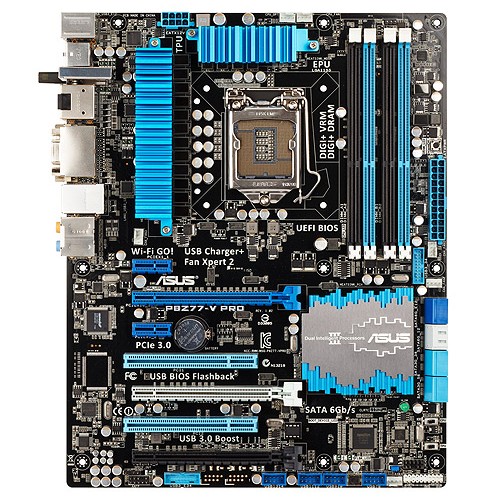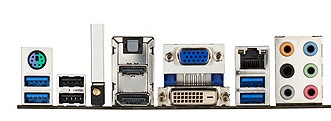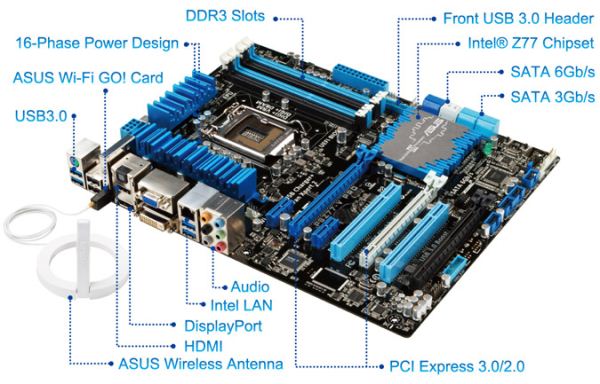Intel Z77 Panther Point Chipset and Motherboard Preview – ASRock, ASUS, Gigabyte, MSI, ECS and Biostar
by Ian Cutress on April 8, 2012 12:00 AM EST- Posted in
- Motherboards
- Intel
- Biostar
- MSI
- Gigabyte
- ASRock
- Asus
- Ivy Bridge
- ECS
- Z77
ASUS P8Z77-V Pro—Visual Inspection
ASUS have a lot to live up to with its Ivy Bridge Pro board. Both the ASUS P8P67 Pro and ASUS P8Z68-V Pro have been top class sellers in their respective chipsets, meaning that ASUS has to deliver. Thankfully, by just looking at the board, it seems that ASUS is keen to innovate and offer a complete package.
Using a 12 + 4 VRM power delivery system, the ASUS P8Z77-V Pro sports a blue and black livery synonymous with their channel / non-ROG products. The VRM heatsinks cover a lot of surface area in their jagged fashion, and around the socket itself, we have access to five main fan headers. Two of these are CPU 4-pin headers just north of the top VRM heatsink, one 4-pin below the left hand side VRM heatsink, and two 4-pin headers below the 24-pin ATX power connector, along with a USB 3.0 port. A sixth fan header (4-pin) is found on the south side of the board.

Above the 24-pin ATX power connector, we find the ASUS MemOK! button, which allows memory recovery to default speeds. Along with the ASRock boards, we have eight SATA ports—four SATA 3 Gbps from the PCH and four SATA 6 Gbps—two from the PCH and two more from an ASMedia controller. Below this are the TPU and EPU switches, designed for enhanced CPU performance and energy saving modes respectively.

Along the bottom of the board is the standard array of a front panel audio header, another USB 3.0 header, USB 2.0 headers, and a front panel header. In terms of PCIe layout, despite there being three full-length PCIe connectors on board, we are only limited to using two for multi-GPU setups. In order, we have a PCIe x1, a PCIe 3.0 x16 (x8 in dual GPU), x1, PCI, PCIe 3.0 x8, PCI, and a PCIe 2.0 x4. Thus in dual GPU mode, similarly to the ASRock Extreme6, we can also add in a PCIe x1 and PCIe x4 card.
The chipset heatsink is indicative of the large but low philosophy of many motherboard manufacturers, hiding away the chipset controller. What is not on these boards, as you may notice, is a combination power/reset pair of buttons, nor a two-digit debug, some of which we used to see on ASUS Pro boards of old. Nevertheless, the ASUS board in return makes up for it on the back IO panel.

On the back panel, we have a combination PS/2 port, two USB 3.0 ports (blue), two USB 2.0 ports (black), an ASUS Wi-Fi GO! Card, optical SPDIF output, HDMI, DisplayPort, D-Sub, DVI-D, gigabit Ethernet, two more USB 3.0 ports in blue, and standard audio headers.
This means that rather than add in a WiFi module on the board, or use up a mini-PCIe slot with wifi, we have a slot in order to add a WiFi module. This can be in 2.4 GHz or 5 GHz mode, and updateable as WiFi standards change. This all comes as part of the package, with magnetic wireless antenna to attach to the case.
Board Features
| ASUS P8Z77-V Pro | |
| Size | ATX |
| CPU Interface | LGA-1155 |
| Chipset | Intel Z77 |
| Power Delivery | 12 + 4 |
| Memory Slots |
Four DDR3 DIMM slots supporting up to 32 GB Up to Dual Channel |
| Video Outputs | DisplayPort, HDMI 1.4a, DVI-D, D-Sub |
| Onboard LAN | Intel 82579V |
| Onboard Audio | Realtek ALC892 |
| Expansion Slots |
2 x PCIe x16 Gen3 (x16, x8/8) 1 x PCIe x16 Gen2 (x4) 2 x PCIe x1 Gen2 2 x PCI |
| Onboard SATA/RAID |
2 x SATA 6 Gbps (PCH), Support for RAID 0, 1, 5, 10 2 x SATA 6 Gbps (ASMedia) 4 x SATA 3 Gbps (PCH), Support for RAID 0, 1, 5, 10 |
| USB |
Four USB 3.0 at rear (2 PCH, 2 ASMedia) Two USB 3.0 headers on board (PCH, ASMedia) Ten USB 2.0 (2 back panel, 8 on board) |
| Onboard |
4 x SATA 6 Gbps 4 x SATA 3 Gbps 2 x USB 3.0 Headers 4 x USB 2.0 Headers 6 x Fan Headers 1 x SPDIF Header 1 x Front Panel Audio Header MemOK! Button TPU/EPU Switches USB Flashback Button |
| Power Connectors |
1 x 24-pin ATX connector 1 x 8-pin 12V connector |
| Fan Headers |
1 x CPU Fan Header (4-pin) 4 x CHA Fan Headers 1 x OPT Fan Header |
| IO Panel |
1 x PS/2 Combo Port 1 x DisplayPort 1 x HDMI 1.4a 1 x DVI-D 1 x D-Sub 1 x Gigabit Ethernet 4 x USB 3.0 2 x USB 2.0 1 x Optical SPDIF 1 x WLAN Connector 6 x Audio Jacks |
| Warranty Period | 3 Years |
| Product Page | Link |
ASUS as a direct standard are now placing Intel NICs on all their channel motherboards. This is a result of a significant number of their user base requesting them over the Realtek solutions. Also to note are a total of six USB 3.0 on board, two on the back panel and four from internal headers. These USB 3.0 ports can take advantage of the improved UASP USB 3.0 protocol using appropriate hardware and some ASUS software. As always, we expect ASUS fan control of the six headers to be top notch.











145 Comments
View All Comments
Zoomer - Tuesday, April 10, 2012 - link
So when is AMD buying them out and integrating this in their gfx cards / platform?neo55 - Sunday, April 8, 2012 - link
Will Z77 support two or three monitors simultaneously?GreenEnergy - Sunday, April 8, 2012 - link
You mean from the Ivy Bridge IGP?Well depends. (Its the same btw for H77, Z75 and Z77 etc.). You need to have 2 displayport if I remember correctly. So if you got for example DVI, HDMI and DP. Then 2 screens only. If you got DVI, DP, DP then 3. Or if you daisychain the DP?
dubyadubya - Sunday, April 8, 2012 - link
Listing fan header count and layout is useless if you do not test the functionality. Do they report RPM? Can they control fan speed? Does the fan control work with Speedfan etc. or only the software from the motherboard manufacturer? Several years ago many people including myself brought this to Anandtech's attention. At the time Anandtech stated they would include this missing info which they did. Trouble is the info was only included in one or two reviews before it was dropped. When I purchase a new motherboard I want to know this info. I have spent many hours searching for this info for each new build as most manufactures do not give detailed info even in the motherboard manual.IMO if a fan header exists it must have full functionality. If not the header should not be on the board. Motherboard manufactures need to pull their heads out of their asses. If Anandtech reported this info in reviews and gave negative reviews on boards with poor fan support the manufacturers would get the hint.
Nje - Sunday, April 8, 2012 - link
Yeah I would love to know this, particularly if the fan headers can control 3 pin fans as well (ie vary the voltage).ASUSTechMKT - Monday, April 9, 2012 - link
Primary CPU headers ( CPU and CPU OPT are fully controllable for 4 pin ) as the majority of CPU coolers are PWM for chassis headers ( 1-4 all allow for 3 pin and 4 pin fan control ).Zoomer - Tuesday, April 10, 2012 - link
Asus, can they be used with speedfan or is it BIOS/Asus software only?ASUSTechMKT - Monday, April 9, 2012 - link
This has been noted in the last couple of reviews. Specifically for ASUS we have spent considerable time putting quality fan controls on our boards all headers allow for 3 presets as well as min and max rotation and target temperatures. In addition with our software for this generation we offer full calibration per each header that can sense the min and max rotation and provide this information as well as sync this data to the profiles. Overall it is quite extensive make sure to check out our videos coming up which shows it in great depth.Arbie - Monday, April 9, 2012 - link
@dubyadubya - Look on the bright side: at least one manufacturer (Asus) takes fans seriously, and at least one reviewer (Anandtech) is even mentionng the fact.I have the same wants as you do, and have made the same requests, but be reasonable. These aren't full motherboard reviews! They don't even have the boards operable, much less any hands-on time with BIOS details.
And when they do have all that, a higher priority will be PCIe lanes and how many graphics cards can be stuffed in. That's because you can't run any modern games with only one board.
But then they might talk a little more about the fan controls... Let's hope. Again - be glad that even one vendor is paying attention and has included some controls to be talked about.
Cavalcade - Sunday, April 8, 2012 - link
With a slightly more than passing knowledge of rendering, and having spent a fair amount of time handling input in a game engine, I'm curious as to how Lucid came to the responsiveness numbers in the chart on page 3. The concept seems valid at first glance, but the numbers strike me as pure marketing fodder as opposed to solid and testable results.Also, this sort of technology seems far better suited to residing in the driver layer as opposed to yet another piece of middleware for PC gamers to contend with. We're already effectively blocked from the hardware, and forced to go through third-party graphics APIs (Direct3D/OpenGL).
Maybe it's a "you have to see it (feel it)" kind of thing, but from here you can color me skeptical.